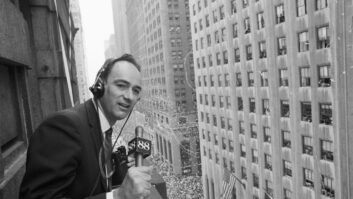CBS Labs ruled the roost long before names like Orban, Texar and Cutting Edge came to dominate the on-air audio processing scene in the late 20th century. Its Audimax AGC and AM/FM Volumax peak limiters were introduced in the late 1950s and early 1960s, respectively. Improved models continued to dominate the market well into the 1970s.
This installment of “Plugged Into the Past” looks at the last of the Audimax series: the 4400.

Audimax I was introduced in 1959 as an all-tube design. Sales were not brisk, probably due to a rather exorbitant price. Subsequent designs in the 400 series were solid-state and more reasonably priced. Sales soon took off. In 1972, the 2RU 400-series Audimax was replaced by the 4400, in a slimline 1RU package.
Audio amplification was provided by a push-pull balanced circuit, with transformerless input and transformer output followed by a 6 dB pad. The input signal is sampled after the first stage, rectified, and used as the control voltage for the logic circuit.
The Audimax’s magic came from the GGS or Gated Gain Stabilizer circuit. Its purpose was to decide when to increase gain, and when to freeze it at a low level. Conventional AGC amps would increase gain to the maximum during periods of dead air or very low levels, sucking up all the system noise along with it. Gated AGCs all had some type of circuit to prevent this.
The first 4400s were designed so the bottom chassis and electronics could slide out of the rack mount, speeding up bench tests and repairs, and these are illustrated in our photo shoot.
As long as you had the mating Blue Ribbon connector wired to an audio oscillator and distortion meter, along with a matching AC cord, bench work was a plug-and-play operation. For servicing, PC boards would snap off the chassis, and wiring was terminated with pin connectors. Test points were clearly marked.
As a practical matter, these units were very well-designed, and component failures were rare. All that was usually required was to change out the power supply caps every five years or so, and go through the alignment annually. The manual was comprehensive and well written.
[More history: Audimax Memories]
The pictured units are 4440 mono devices, but field conversion to 4450 stereo was a simple process. All that was needed was the installation of an additional A1 audio board on the right side of the chassis, replacement of the blank panel on the right side with one which had input/output pots and a control switch, along with wiring it all up with pin connectors. Conversion kits to make a 4440 into a 4450 were readily available from CBS.

CBS Labs
CBS Laboratories has its origins in 1936, a time when the leading radio networks and manufacturers had their own research facilities. The intent was to keep the organization ahead of the technology curve by developing advanced devices. In the case of CBS and a few others, the sale of said devices would also defray some of the development costs.
Originally located in New York City, the labs eventually outgrew the space, and in 1958 moved to more spacious headquarters in Stamford, Conn. CBS Labs developed many innovative products for both radio and television, and several of the TV products won Emmy Awards. The original CBS Audimax I was introduced in 1959. Other memorable audio innovations from CBS Labs include the 33 1/3 RPM record and in 1971 the SQ system of quadraphonic sound.
In 1975, CBS Labs was reorganized. The manufacturing arm, CLD Professional Products Department, was sold off to Thomson-CSF and renamed Thomson-CSF Laboratories. Although Thomson was a French company, manufacturing continued in Stamford. The R&D division was renamed CBS Technology Center and remained in the original Stamford headquarters.
The end came in 1986, when Laurence Tisch assumed the helm of CBS. At that time, the network was in a state of financial and operational turmoil. Soon after taking over, Tisch closed the Technology Center as part of a belt-tightening move.
While Audimax and Volumax were the company’s best-known radio products, there were others. The CBS 4500 Dynamic Presence Equalizer, dating from 1973, was designed to enhance poor-quality voice content, as might come from noisy remote lines, azimuth alignment errors or incorrect line equalization. In the speech-only mode, the 4500 would detect speech content and boost the signal in the 2–4 kHz “presence band” if it was too low. It could also be set to process everything.
The Model 700 loudness indicator was introduced in 1968 and was the outcome of a three-year research project with the CBS radio and television networks. It had long been known that some program content seemed louder than other material, even though the VU meter readings were the same. The lab’s research uncovered several factors that contributed to perceived loudness, and the 700 provided a quantitative indication of these. This was a landmark device, and a major turning point in the AM loudness wars.
CBS products are also remembered for their “mystery modules,” bits of proprietary circuitry encapsulated in potting compound contained in small metal modules. One of these is pictured on the power supply board of the 4400. It controlled the logic of the gating action. The origin of these modules in industrial electronics is murky, and CBS was probably not the first to do this. They certainly brought the practice into the broadcasting realm. Other manufacturers followed suit, particularly with audio processors. Orban had some, as did Modulation Sciences, with its CP-803 composite processor.
Pre-War Period
In the history of audio processors, the CBS Audimax belongs in the chapter titled “The Calm Before the Storm.” It was designed and used at the time when the sole purpose of processors was to maintain modulation between 85 to 100% modulation, as specified by the FCC. Soon, the AM loudness wars would begin, then AGCs and peak limiters would evolve into tools to create a unique “sound” for the station and also to blow the competition off the dial.
Along the way, the basic broadband gated AGC would take some important evolutionary steps. When pushed hard, the sound of the AGC could best be described as unnatural. That was usually because one portion of the audio spectrum, typically the bass, was controlling the AGC action. This was particularly noticeable with disco.
At this time, much of the brain trust in broadcast engineering resided in the engineering departments, particularly at major market radio stations. Research, brainstorming, designing and tinkering with the broadband AGC design began. One of the outcomes was multiband limiting. The optimal number of bands, how to set the crossover between them, and how to process each was an ongoing debate.
Those first multiband processors were really hybrids of manufactured gear and homemade devices. One of the earliest was at WRKO in Boston. It occupied an entire equipment rack at the transmitter site. Similar efforts were underway at WABC New York, CKLW Windsor, Ontario, and other stations. The first commercially available multiband processor was the Dorrough Electronics 310 DAP.
No less than three Audimax 4440s live in my attic. One was found while cleaning out a transmitter building, the other two were being tossed when a station moved for consolidation. At the time they were acquired, we were well into the Age of Orban and the Age of Texar, so no attempt has been made to test or revive them. As with many pieces of broadcast gear that are well past their prime, they make great display items for the office.












